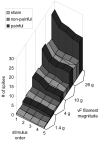Neuronal hyperexcitability in the dorsal horn after painful facet joint injury
- PMID: 20739124
- PMCID: PMC2955815
- DOI: 10.1016/j.pain.2010.07.034
Neuronal hyperexcitability in the dorsal horn after painful facet joint injury
Abstract
Excessive cervical facet capsular ligament stretch has been implicated as a cause of whiplash-associated disorders following rear-end impacts, but the pathophysiological mechanisms that produce chronic pain in these cases remain unclear. Using a rat model of C6-C7 cervical facet joint capsule stretch that produces sustained mechanical hyperalgesia, the presence of neuronal hyperexcitability was characterized 7 days after joint loading. Extracellular recordings of spinal dorsal horn neuronal activity between C6 and C8 (117 neurons) were obtained from anesthetized rats, with both painful and non-painful behavioral outcomes established by the magnitude of capsule stretch. The frequency of neuronal firing during noxious pinch (p<0.0182) and von Frey filaments applications (4-26g) to the forepaw was increased (p<0.0156) in the painful group compared to the non-painful and sham groups. In addition, the incidence and frequency of spontaneous and after discharge firing were greater in the painful group (p<0.0307) relative to sham. The proportion of cells in the deep laminae that responded as wide dynamic range neurons also was increased in the painful group relative to non-painful or sham groups (p<0.0348). These findings suggest that excessive facet capsule stretch, while not producing visible tearing, can produce functional plasticity of dorsal horn neuronal activity. The increase in neuronal firing across a range of stimulus magnitudes observed at day 7 post-injury provides the first direct evidence of neuronal modulation in the spinal cord following facet joint loading, and suggests that facet-mediated chronic pain following whiplash injury is driven, at least in part, by central sensitization.
Copyright © 2010 International Association for the Study of Pain. Published by Elsevier B.V. All rights reserved.
Figures






Similar articles
-
Spinal neuronal plasticity is evident within 1 day after a painful cervical facet joint injury.Neurosci Lett. 2013 May 10;542:102-6. doi: 10.1016/j.neulet.2013.03.019. Epub 2013 Mar 21. Neurosci Lett. 2013. PMID: 23523644 Free PMC article.
-
An intact facet capsular ligament modulates behavioral sensitivity and spinal glial activation produced by cervical facet joint tension.Spine (Phila Pa 1976). 2008 Apr 15;33(8):856-62. doi: 10.1097/BRS.0b013e31816b4710. Spine (Phila Pa 1976). 2008. PMID: 18404104
-
Gabapentin alleviates facet-mediated pain in the rat through reduced neuronal hyperexcitability and astrocytic activation in the spinal cord.J Pain. 2013 Dec;14(12):1564-72. doi: 10.1016/j.jpain.2013.07.016. Epub 2013 Oct 4. J Pain. 2013. PMID: 24094695 Free PMC article.
-
Pain generation in lumbar and cervical facet joints.J Bone Joint Surg Am. 2006 Apr;88 Suppl 2:63-7. doi: 10.2106/JBJS.E.01411. J Bone Joint Surg Am. 2006. PMID: 16595446 Review.
-
Alterations in evoked and spontaneous activity of dorsal horn wide dynamic range neurons in pathological pain: a systematic review and analysis.Pain. 2019 Oct;160(10):2199-2209. doi: 10.1097/j.pain.0000000000001632. Pain. 2019. PMID: 31149976
Cited by
-
Thrombospondin-4 and excitatory synaptogenesis promote spinal sensitization after painful mechanical joint injury.Exp Neurol. 2015 Feb;264:111-20. doi: 10.1016/j.expneurol.2014.11.015. Epub 2014 Dec 5. Exp Neurol. 2015. PMID: 25483397 Free PMC article.
-
The Interface of Mechanics and Nociception in Joint Pathophysiology: Insights From the Facet and Temporomandibular Joints.J Biomech Eng. 2017 Feb 1;139(2):0210031-02100313. doi: 10.1115/1.4035647. J Biomech Eng. 2017. PMID: 28056123 Free PMC article. Review.
-
Kv7.2 regulates the function of peripheral sensory neurons.J Comp Neurol. 2014 Oct 1;522(14):3262-80. doi: 10.1002/cne.23595. Epub 2014 Apr 12. J Comp Neurol. 2014. PMID: 24687876 Free PMC article.
-
Spinal neuronal plasticity is evident within 1 day after a painful cervical facet joint injury.Neurosci Lett. 2013 May 10;542:102-6. doi: 10.1016/j.neulet.2013.03.019. Epub 2013 Mar 21. Neurosci Lett. 2013. PMID: 23523644 Free PMC article.
-
The role of tissue damage in whiplash-associated disorders: discussion paper 1.Spine (Phila Pa 1976). 2011 Dec 1;36(25 Suppl):S309-15. doi: 10.1097/BRS.0b013e318238842a. Spine (Phila Pa 1976). 2011. PMID: 22020601 Free PMC article. Review.
References
-
- Banic B, Petersen-Felix S, Andersen OK, Radanov BP, Villiger PM, Arendt-Nielsen L, Curatolo M. Evidence for spinal cord hypersensitivity in chronic pain after whiplash injury and in fibromyalgia. Pain. 2004;107(1–2):7–15. - PubMed
-
- Barnsley L, Lord S, Bogduk N. Comparative local anaesthetic blocks in the diagnosis of cervical zygapophysial joint pain. Pain. 1993;55(1):99–106. - PubMed
-
- Barnsley L, Lord SM, Wallis BJ, Bogduk N. The prevalence of chronic cervical zygapophysial joint pain after whiplash. Spine. 1995;20(1):20–25. - PubMed
-
- Beaman DN, Graziano GP, Glover RA, Wojtys EM, Chang V. Substance P innervation of lumbar spine facet joints. Spine. 1993;18(8):1044–1049. - PubMed
-
- Cavanaugh JM, Lu Y, Chen C, Kallakuri S. Pain generation in lumbar and cervical facet joints. J Bone Joint Surg Am. 2006;88 (Suppl 2):63–67. - PubMed
Publication types
MeSH terms
Grants and funding
LinkOut - more resources
Full Text Sources
Medical
Miscellaneous

